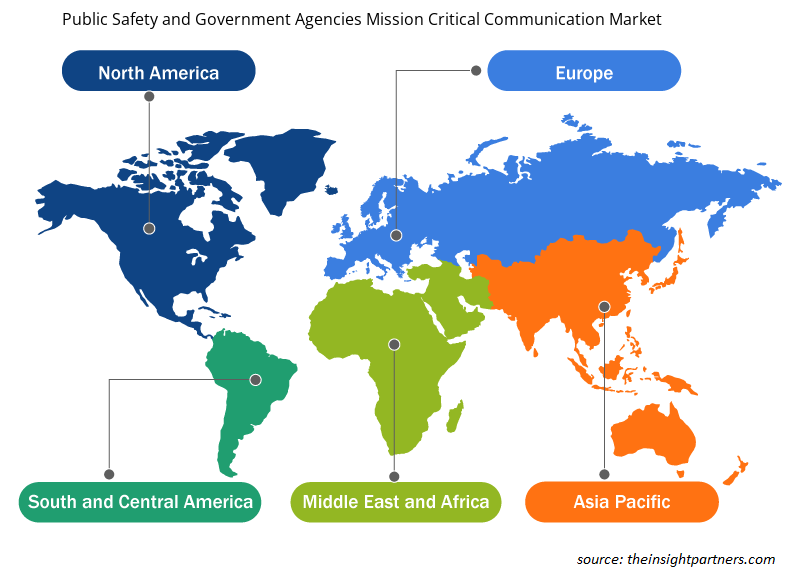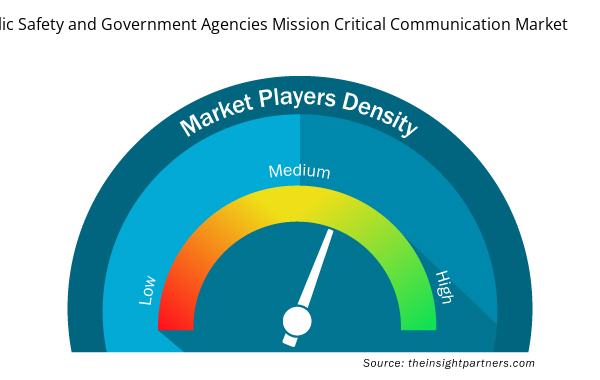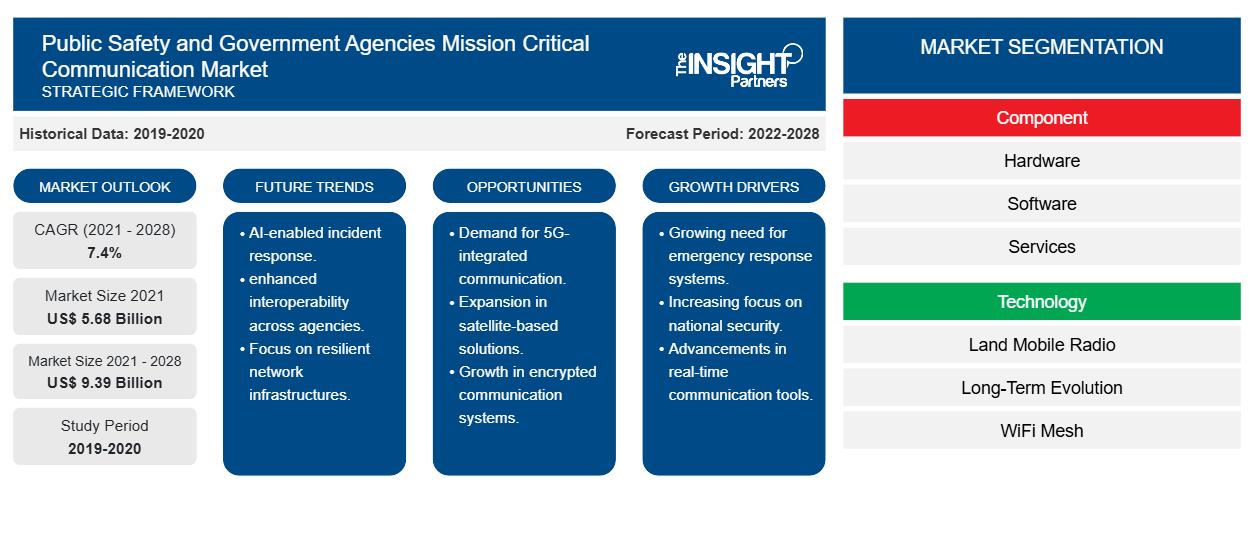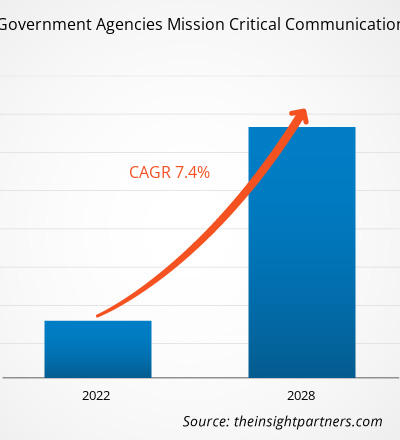2021 年公共安全和政府机构关键任务通信市场价值为 56.843 亿美元,预计到 2028 年将达到 93.9 亿美元;预计 2021 年至 2028 年的复合年增长率为 7.4%。
关键任务通信涉及在传统系统无法满足最终用户需求的情况下帮助最终用户使用通信方法的解决方案。此外,公共安全和政府机构的关键任务通信市场促进通信并支持对人员和财产充满危险的行动。关键通信设备用于教育人们了解危急情况。在公共安全和政府机构的关键任务通信市场中,网络运营商专注于通信基础设施的新设计和管理策略,以应对快速的网络和服务发展,确保可靠的网络运行。
COVID-19 疫情对公共安全和政府机构关键任务通信市场的影响
COVID-19 疫情严重影响了北美公共安全和政府机构关键任务通信市场,给终端使用行业造成了巨大的财务损失,迫使它们进一步推迟 MCX 实施计划。疫情还影响了公共安全和政府机构关键任务通信市场硬件制造工厂的运营,导致工厂短暂停工。因此,几家重要的零部件供应商和技术供应商削减了成本和产量。由于对电子产品的需求保持不变,这有助于市场恢复增长。
定制此报告以满足您的需求
您可以免费定制任何报告,包括本报告的部分内容、国家级分析、Excel 数据包,以及为初创企业和大学提供优惠和折扣
- 获取此报告的关键市场趋势。这个免费样品将包括数据分析,从市场趋势到估计和预测。
市场洞察
各政府机构需求不断增长推动公共安全和政府机构关键任务通信市场的增长
公民期望政府机构每天 24 小时提供服务和通信。他们希望能够轻松获取正确、最新的信息,并与相关政府官员顺利联系。他们还希望服务能够迅速、有效和透明地提供,问题能够迅速、有效和公开地得到解决。许多政府机构仍然依赖过时的通信基础设施,例如租用的 PBX 系统或 Centrex 型系统。此外,在公共安全和政府机构任务关键型通信市场中,政府正在开发和维护出色的通信系统,以成为公共领域受人尊敬的参与者。上述因素使他们能够评估居民的需求和偏好,并促进多方利益相关者参与、知情政策辩论和应急发展效力的协商公共领域。所有这些问题都推动了对公共安全和政府机构任务关键型通信市场的需求。
基于组件的市场洞察
公共安全和政府机构关键任务通信市场的硬件组件包括指挥和控制中心、路由器和网关以及分布式管理系统。硬件组件的部署因公共安全机构的性质而异。全球报告的犯罪数量不断增加,推动了对公共安全和政府机构关键任务通信市场的需求。
基于技术的市场洞察
陆地移动无线电 (LMR),也称为双向无线电,是公共安全和政府机构任务关键型通信市场中最广泛使用的通信技术之一。该技术不断接受测试和改进,被视为关键通信(尤其是公共安全领域)成功的基准。
在公共安全和政府机构关键任务通信市场中,产品开发是公司扩大产品组合的常用策略,这有助于他们扩大客户群并维护品牌知名度。市场近期的一些关键发展如下:
- 2021 年,印度尼西亚共和国政府部署了从 Iridium Communications Inc. 采购的 500 台 Iridium 一键通 (PTT) 设备,以促进全国的通信运营。印度尼西亚政府现在拥有可靠的“随身携带”实时卫星通信解决方案,适合在该国众多岛屿景观中进行移动通信。
- 2021 年,Inmarsat 确认其在印度的战略合作伙伴 BSNL 已获得提供 Inmarsat 世界一流的 Global Xpress (GX) 移动宽带服务所需的许可证。根据电信部颁发的 BSNL 机上和海上连接 (IFMC) 许可证,GX 将提供给印度政府、航空和海洋领域的客户。
公共安全和政府机构关键任务通信市场区域洞察
Insight Partners 的分析师已详尽解释了预测期内影响公共安全和政府机构关键任务通信市场的区域趋势和因素。本节还讨论了公共安全和政府机构关键任务通信市场在北美、欧洲、亚太地区、中东和非洲以及南美和中美洲的细分市场和地理位置。

- 获取公共安全和政府机构关键任务通信市场的区域特定数据
公共安全和政府机构关键任务通信市场报告范围
| 报告属性 | 细节 |
|---|---|
| 2021 年市场规模 | 56.8亿美元 |
| 2028 年市场规模 | 93.9亿美元 |
| 全球复合年增长率(2021 - 2028) | 7.4% |
| 史料 | 2019-2020 |
| 预测期 | 2022-2028 |
| 涵盖的领域 | 按组件
|
| 覆盖地区和国家 | 北美
|
| 市场领导者和主要公司简介 |
|
公共安全和政府机构关键任务通信市场参与者密度:了解其对业务动态的影响
公共安全和政府机构关键任务通信市场正在快速增长,这得益于最终用户需求的不断增长,而这些需求又源于消费者偏好的不断变化、技术进步以及对产品优势的认识不断提高等因素。随着需求的增加,企业正在扩大其产品范围,进行创新以满足消费者的需求,并利用新兴趋势,从而进一步推动市场增长。
市场参与者密度是指在特定市场或行业内运营的企业或公司的分布情况。它表明在给定市场空间中,相对于其规模或总市场价值,有多少竞争对手(市场参与者)存在。
在公共安全和政府机构关键任务通信市场运营的主要公司有:
- Ascom 控股公司(Ascom)
- 全球星
- 国际海事卫星组织全球有限公司
- 铱星通信公司
- nbn 有限公司
免责声明:上面列出的公司没有按照任何特定顺序排列。

- 获取公共安全和政府机构关键任务通信市场顶级关键参与者概述
公共安全和政府机构关键任务通信市场细分:
按组件
- 硬件
- 软件
按技术分类
- 长期演进 (LTE)
- 陆地移动无线电 (LMR)
- WiFi 网状网络
公司简介
- Ascom 控股公司(Ascom)
- 全球星
- 国际海事卫星组织全球有限公司
- 铱星通信公司
- nbn 有限公司
- 南非
- 电信卫星公司
- 舒拉亚电信公司
- AT&T 公司
- 太空运输公司
- 历史分析(2 年)、基准年、预测(7 年)及复合年增长率
- PEST 和 SWOT 分析
- 市场规模价值/数量 - 全球、区域、国家
- 行业和竞争格局
- Excel 数据集



Report Coverage
Revenue forecast, Company Analysis, Industry landscape, Growth factors, and Trends

Segment Covered
This text is related
to segments covered.

Regional Scope
North America, Europe, Asia Pacific, Middle East & Africa, South & Central America

Country Scope
This text is related
to country scope.
常见问题
North America is known for placing a high value on public safety, with regional and national governments devoting large resources to the cause. For example, in 2020, the New York Police Department had a budget of $5.92 billion, the Los Angeles Police Department had a budget of $1.86 billion, the Chicago Police Department had a budget of $1.76 billion, the Philadelphia Police Department had a budget of $4.9 billion, and the Toronto Police Department had a budget of $1.22 billion.
In terms of market share, the market was dominated by the Long-Term Evolution (LTE) segment, which accounted for 49.7% of the total market share in 2020 and is expected to reach 47.8% of the market share by 2028. Long term evolution (LTE), commonly known as 4G (Fourth Generation) wireless standard, offers increased network capacity and speed for cellular communication devices. LTE offers up to 100 Mbps of download and 30 Mbps upload speed. One of the biggest advantages of using LTE in mission critical communication is data connectivity. Prior to LTE, the mission critical communication was majorly voice based with limited data usage. The introduction of LTE bought a wide range of applications, such as broadcasting or multi-casting, live streaming, and device-to-device communications in mission critical communication. LTE is capable of unify the existing mission critical networks based on disparate technologies, such as terrestrial trunked radio (TETRA), ultra high frequency (UHF), and very high frequency (VHF). Moreover, with the increasing use of connected devices such as drones and cameras by public safety agencies, the adoption of LTE for mission critical communication is expected to witness a significant growth during the forecast period.
A few key players operating in the public safety and government agencies mission critical communication (MCX) market are Ascom Holding AG (Ascom), Globalstar, Inmarsat Global Limited, Iridium Communications Inc., nbn co ltd., SES S.A., Telesat, Thuraya Telecommunications Company, AT&T Inc., and SPACEX, which are profiled in the report.
The global Public Safety and Government agencies mission critical communication (MCX) market was dominated by the hardware segment in 2020, which accounted for 49.1% of market share. The hardware segment is anticipated to continue its dominance during the forecast period as well. The mission critical communication is one of the prominent systems offering public safety agencies a dedicated communication platform. The hardware component of mission critical communication consists of command and control center, router and gateways, and distribution management system. The deployment of hardware component various and differs according to the nature of public safety agency. The growing number of criminal reporting across the world propels the demand for mission critical communications by public safety agencies worldwide, which drives the market growth for the hardware segment.
Many lives are lost as a result of natural calamities. Some losses could have been avoided if public agencies had offered timely information about the nature of the crisis and how to respond. For example, many lives could have been saved in Thailand in 2004 if PSAs had warned the people of the impending tidal wave. In addition, public warnings can be helpful in situations like terrorist attacks and other catastrophic events, such as the Fukushima Daichi nuclear power plant accident and the Tianjin port explosion. For this reason, public warnings share many characteristics of mission-critical communications. When properly hardened, commercial 3G and 4G networks can provide PSAs with performance and dependability superior to private radio networks. Government agencies can develop additional sites for increased redundancy, capacity, and coverage to raise backhaul bandwidth and improve physical security. The mobile network's resiliency and robustness will be increased due to this 'hardening,' such that in the case of a power outage or network infrastructure damage, the network can remain operational for a prolonged length of time. It is vital to guarantee that the standards for products and services that supply mission-critical communications are of the highest possible quality because there are scenarios where a service failure could have disastrous implications. Therefore, sufficient efforts are made to build resilient products. Mission-critical communications are not limited to a relatively small market, such as public safety, but rather that economies of scale are fully leveraged so that the additional development costs required to ensure the desired quality are shared across a more extensive user base.
The Public Safety and Government agencies mission critical communication (MCX) market is growing because of the global rise in terrorism, public safety, and desire for a reliable network during emergencies. However, the market's growth is hampered by high implementation costs, restricted data transit capabilities, and limited spectrum bandwidth. Government investments in mission-critical communication systems in the defense sector, on the other hand, are likely to generate attractive prospects for the industry in the coming years.
Trends and growth analysis reports related to Electronics and Semiconductor : READ MORE..
The List of Companies - Public Safety and Government Agencies Mission Critical Communication Market
- Ascom Holding AG (Ascom)
- Globalstar
- Inmarsat Global Limited
- Iridium Communications Inc.
- nbn co ltd.
- SES S.A.
- Telesat
- Thuraya Telecommunications Company
- AT&T Inc.
- SPACEX
The Insight Partners performs research in 4 major stages: Data Collection & Secondary Research, Primary Research, Data Analysis and Data Triangulation & Final Review.
- Data Collection and Secondary Research:
As a market research and consulting firm operating from a decade, we have published and advised several client across the globe. First step for any study will start with an assessment of currently available data and insights from existing reports. Further, historical and current market information is collected from Investor Presentations, Annual Reports, SEC Filings, etc., and other information related to company’s performance and market positioning are gathered from Paid Databases (Factiva, Hoovers, and Reuters) and various other publications available in public domain.
Several associations trade associates, technical forums, institutes, societies and organization are accessed to gain technical as well as market related insights through their publications such as research papers, blogs and press releases related to the studies are referred to get cues about the market. Further, white papers, journals, magazines, and other news articles published in last 3 years are scrutinized and analyzed to understand the current market trends.
- Primary Research:
The primarily interview analysis comprise of data obtained from industry participants interview and answers to survey questions gathered by in-house primary team.
For primary research, interviews are conducted with industry experts/CEOs/Marketing Managers/VPs/Subject Matter Experts from both demand and supply side to get a 360-degree view of the market. The primary team conducts several interviews based on the complexity of the markets to understand the various market trends and dynamics which makes research more credible and precise.
A typical research interview fulfils the following functions:
- Provides first-hand information on the market size, market trends, growth trends, competitive landscape, and outlook
- Validates and strengthens in-house secondary research findings
- Develops the analysis team’s expertise and market understanding
Primary research involves email interactions and telephone interviews for each market, category, segment, and sub-segment across geographies. The participants who typically take part in such a process include, but are not limited to:
- Industry participants: VPs, business development managers, market intelligence managers and national sales managers
- Outside experts: Valuation experts, research analysts and key opinion leaders specializing in the electronics and semiconductor industry.
Below is the breakup of our primary respondents by company, designation, and region:

Once we receive the confirmation from primary research sources or primary respondents, we finalize the base year market estimation and forecast the data as per the macroeconomic and microeconomic factors assessed during data collection.
- Data Analysis:
Once data is validated through both secondary as well as primary respondents, we finalize the market estimations by hypothesis formulation and factor analysis at regional and country level.
- Macro-Economic Factor Analysis:
We analyse macroeconomic indicators such the gross domestic product (GDP), increase in the demand for goods and services across industries, technological advancement, regional economic growth, governmental policies, the influence of COVID-19, PEST analysis, and other aspects. This analysis aids in setting benchmarks for various nations/regions and approximating market splits. Additionally, the general trend of the aforementioned components aid in determining the market's development possibilities.
- Country Level Data:
Various factors that are especially aligned to the country are taken into account to determine the market size for a certain area and country, including the presence of vendors, such as headquarters and offices, the country's GDP, demand patterns, and industry growth. To comprehend the market dynamics for the nation, a number of growth variables, inhibitors, application areas, and current market trends are researched. The aforementioned elements aid in determining the country's overall market's growth potential.
- Company Profile:
The “Table of Contents” is formulated by listing and analyzing more than 25 - 30 companies operating in the market ecosystem across geographies. However, we profile only 10 companies as a standard practice in our syndicate reports. These 10 companies comprise leading, emerging, and regional players. Nonetheless, our analysis is not restricted to the 10 listed companies, we also analyze other companies present in the market to develop a holistic view and understand the prevailing trends. The “Company Profiles” section in the report covers key facts, business description, products & services, financial information, SWOT analysis, and key developments. The financial information presented is extracted from the annual reports and official documents of the publicly listed companies. Upon collecting the information for the sections of respective companies, we verify them via various primary sources and then compile the data in respective company profiles. The company level information helps us in deriving the base number as well as in forecasting the market size.
- Developing Base Number:
Aggregation of sales statistics (2020-2022) and macro-economic factor, and other secondary and primary research insights are utilized to arrive at base number and related market shares for 2022. The data gaps are identified in this step and relevant market data is analyzed, collected from paid primary interviews or databases. On finalizing the base year market size, forecasts are developed on the basis of macro-economic, industry and market growth factors and company level analysis.
- Data Triangulation and Final Review:
The market findings and base year market size calculations are validated from supply as well as demand side. Demand side validations are based on macro-economic factor analysis and benchmarks for respective regions and countries. In case of supply side validations, revenues of major companies are estimated (in case not available) based on industry benchmark, approximate number of employees, product portfolio, and primary interviews revenues are gathered. Further revenue from target product/service segment is assessed to avoid overshooting of market statistics. In case of heavy deviations between supply and demand side values, all thes steps are repeated to achieve synchronization.
We follow an iterative model, wherein we share our research findings with Subject Matter Experts (SME’s) and Key Opinion Leaders (KOLs) until consensus view of the market is not formulated – this model negates any drastic deviation in the opinions of experts. Only validated and universally acceptable research findings are quoted in our reports.
We have important check points that we use to validate our research findings – which we call – data triangulation, where we validate the information, we generate from secondary sources with primary interviews and then we re-validate with our internal data bases and Subject matter experts. This comprehensive model enables us to deliver high quality, reliable data in shortest possible time.


 获取此报告的免费样本
获取此报告的免费样本